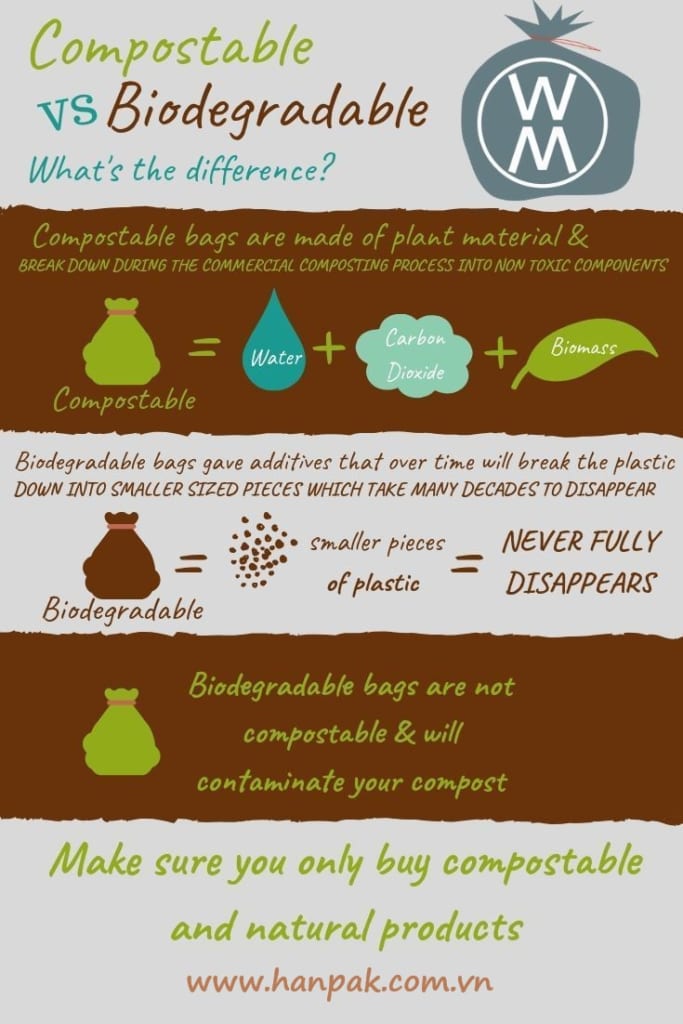What’s the Difference Between Compostable and Biodegradable? Compostable vs Biodegradable Plastic Bags
Basically, compostable and biodegradable plastics share the same main attribute: they are materials that can break down over time in a specific environment. Compostable vs Biodegradable Plastic Bags
But when it comes to how they decompose, the timeframe needed to do so, and what they leave behind – the two materials differ significantly and this plays a significant role in the plastic vs compostable packaging debate.
“Everything that is compostable is biodegradable, but not everything that is biodegradable is compostable.”
Alex Hoang – HANPAK JSC

Compostable Plastic Bags
Compostable plastics – when exposed to the right mixture of oxygen, moisture, and heat – break down into natural, non-toxic elements that promote healthy soil. While some compostable plastics can be placed in home compost, most require a high-temperature industrial facility to decompose successfully.
As compostable plastic breaks down, around 90% of it is converted back into CO2, leaving water and biomass as the remaining byproducts. For bioplastic to be officially certified as compostable, it must decompose at the same speed as organic matter, which is typically within 3-6 months.

Biodegradable Plastics
Biodegradable plastics can be either plant or oil-based and contain additional micro-organisms that slowly break down the material into smaller and smaller pieces. It’s important to note that many biodegradable plastics are still made from petroleum, but with altered chemical properties.
Although biodegradable plastics can decompose, the resulting byproducts may contaminate soil and organic matter, and as such, they cannot be placed into compost. Instead, they generally require processing in specialized facilities, which sadly are not yet available in many areas. When disposed of in the landfill, soil, or the ocean, biodegradable plastics generally decompose no faster than traditional plastic.
“‘Biodegradable’ means something much more limited than what most people would think, and people are more likely to litter items marked as biodegradable.”
Sustainable Packaging Coalition

It’s also worth noting two crucial factors:
– Most bioplastic is not biodegradable. According to the Australasian Bioplastics Association, around 75% of bioplastic is non-biodegradable, despite being.plant-based.
– There is no official degradation period for biodegradable plastic, leaving the term open to being.used misleadingly.

The Hidden Environmental Impacts of Plant-Based Plastics
While packaging that decomposes seems like a perfect solution, we also need to consider. the environmental impacts of creating – or rather, growing – the raw materials.
And many industry experts already view bioplastics as a counter-productive solution.and therefore this weighs heavy when it comes to plastic vs compostable packaging.
As compostable plastics are.made using biomass – such as corn starch,.wood pulp, sugar cane, and wheat straw – there’s a growing.debate about whether creating high volumes of bioplastic is coming at the expense of our food supply.
According to various studies, it takes approximately 2.5 kg of corn to produce one kilogram of PLA. And with global production of plastic hovering around 300 million tons per year, converting all of this into bioplastic would.require 750 million tons of corn – almost double the USA’s entire annual yield.

There are also questions about the increased use of fertilizers, pesticides, GMOs.and water – as well as the extra greenhouse gasses created by farming machinery. A 2010 study by the University of Pittsburgh found that bioplastics often created more.harmful pollutants than petroleum equivalents, due to the farming and chemical processes needed to turn biomass into plastic.
From a carbon emissions perspective, bioplastics have the edge as the.CO2 released during decomposition is equal to the carbon absorbed by the plants. In contrast, oil-based plastics gradually release CO2 that would have otherwise remained underground.
And perhaps most importantly, the study concluded that when plastics – either plant or oil-based – .are created using renewable energy they can reduce 75% of the carbon emissions.
Conclusion: Plastic Packaging or Compostable Packaging?
A lot of people think that using biodegradable garbage bags will always help preserve the environment. However, in reality, everything is not so simple. There are three main reasons:
– First, as compostable bags, there’s a debate about will they affect the food supply because they’re made from plant-based material like cornstarch, sugar cane, etc.
– Second, bioplastics have the CO2 released during decomposition is equal to the CO2 absorbed by the plants. In contrast, oil-based plastics gradually release CO2 that would have otherwise remained underground.
– Third: Biodegradable/Compostable bags, if not properly buried and handled after use, will be no different from normal Plastic bags.
Even so, there is currently no perfect solution to this problem. Biodegradable/Compostable bags are still the most optimal solution at the moment.
We made Biodegradable/Compostable Trash Bag, Shopping Bag too. You could check some of our products here.
Contact us
HANPAK JSC
Website: www.hanpak.com.vn
Office: K03-18T2, CT15 Viet Hung Green Park, Giang Bien, Long Bien, Hanoi, Vietnam 100000
Mobile (WhatsApp): +84 898 545 893
Email: info@hanpak.com.vn
“Your trust, Our Success”
HANPAK JSC

